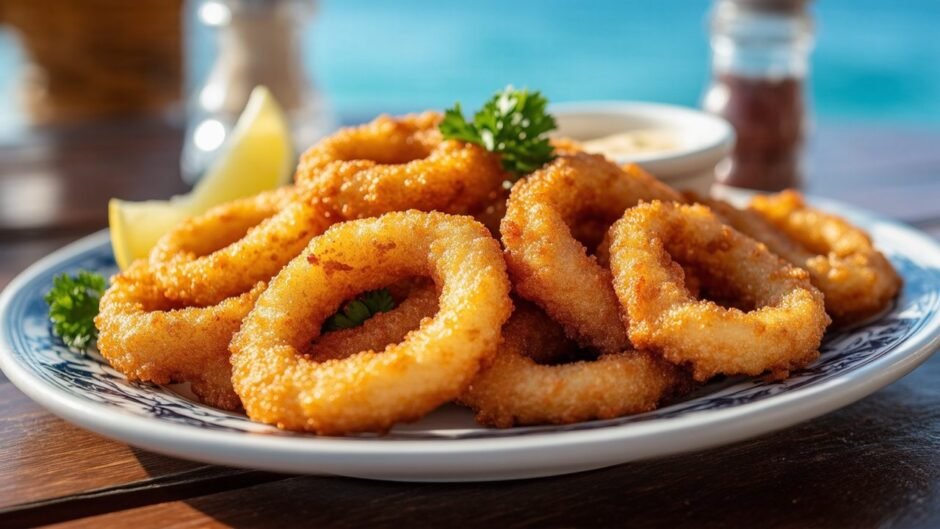The term “calamariere” whispers of sun-drenched Mediterranean coastlines and the sizzle of perfectly cooked seafood. But what does it truly mean? Is it a secret culinary technique, a title for a master chef, or something more? This exploration delves into the world of calamariere, uncovering its origins, the science behind achieving squid perfection, its global culinary expressions, and how you can embrace this ethos in your own kitchen.
Understanding Calamariere: Origins and Meaning
At its heart, calamariere embodies a philosophy of excellence in preparing calamari (squid). It’s more than just a dish; it’s an approach, a dedication to transforming humble squid into a culinary delight. Some interpretations suggest “calamariere” refers to the specific cooking style itself, emphasizing crispy textures and savory flavors, with roots tracing back to 17th-century Venetian fishermen’s journals where masters of squid preparation were highly regarded. These artisans knew how to capture the essence of the sea in every bite.
Linguistically, the term likely blends the Italian “calamari” (squid) with a suffix like “-iere,” often denoting a person associated with a particular skill or trade – think “cavaliere” (knight) or “sommelier.” Thus, a calamariere can also be understood as an individual with profound expertise or a passionate enthusiasm for calamari, someone who truly understands and appreciates the art of its preparation and enjoyment. This dual meaning highlights both the craft and the connoisseurship inherent in the world of exquisite squid dishes.
The Science of Perfect Squid Preparation: The Calamariere Ethos
Achieving calamariere-level squid involves a blend of art and science. It’s about respecting the ingredient and understanding the nuances of cooking. Key principles form the foundation of this culinary pursuit:
- Freshness is Paramount: The journey to perfect calamari begins with the freshest possible squid. Fresh squid offers a tender texture and a clean, oceanic flavor, far from any undesirable fishiness. Culinary experts agree that no amount of skill can fully compensate for starting with subpar ingredients.
- Precision in Preparation: Squid must be sliced uniformly, typically into rings. This ensures even cooking, where each piece achieves that delightful balance – substantial enough for a satisfying chew, yet thin enough to crisp beautifully on the outside.
- The Right Batter: The batter is crucial for texture. A true calamariere opts for a light coating, often using rice flour, tapioca starch, or a fine wheat flour. These create a delicate, crispy shell that doesn’t become heavy or soggy, allowing the squid’s natural flavor to shine.
- Temperature Mastery: Oil temperature is critical. Frying around 175°C (347°F) is generally considered ideal. This precise heat facilitates the Maillard reaction, creating a golden-brown crust and delicious flavor, while cooking the squid quickly to maintain tenderness. Too low, and the calamari becomes greasy; too high, and it risks burning before cooking through.
- Moisture Control: Squid has high water content (around 80%). Patting the squid rings dry before battering is a key step. The light batter then helps to seal in some moisture, keeping the inside succulent, while the hot oil ensures the exterior becomes wonderfully crisp.
Calamariere Across World Cuisines
The spirit of calamariere, though perhaps not always named as such, echoes in various seafood traditions worldwide. Each culture adds its unique fingerprint to the art of cooking squid:
- Italian Traditions: Italy, a likely birthplace of the calamariere ethos, boasts classics like Calamari Fritti (simple, perfectly fried rings, often served with just a lemon wedge) and Fritto Misto, a delightful mix of lightly fried seafood including squid, shrimp, and sometimes small fish or vegetables. Squid also features prominently in pasta dishes like Spaghetti ai Calamari.
- Japanese Flavors: In Japan, squid (ika) is prepared with characteristic precision. Ika Geso Karaage (fried squid tentacles) offers a crispy, umami-rich experience, often found in izakayas. The tempura style, with its incredibly light and airy batter, is another way Japanese cuisine elevates squid.
- Mediterranean Touches: Beyond Italy, grilled calamari is a staple in Greek tavernas, often marinated with olive oil, lemon, and herbs, showcasing a simpler, smokier profile. Spanish cuisine, while perhaps more famous for octopus (pulpo), applies similar principles of fresh ingredients and careful cooking to squid, sometimes seasoned with paprika and garlic.
- Mexican Zest: In Mexico, calamari might be marinated with lime and chili, then quickly grilled or pan-fried, often finding its way into vibrant tacos or served as a zesty appetizer.
Essential Tools and Techniques for the Home Cook
Aspiring to create calamariere-quality dishes at home is achievable with the right tools and techniques. Here’s how to set yourself up for success:
- Kitchen Arsenal:
- A sharp knife or a mandoline slicer for uniform rings.
- A reliable kitchen thermometer to monitor oil temperature accurately.
- A deep-fryer or a heavy-bottomed pot, along with a spider or slotted spoon (or a fry basket).
- A wire cooling rack to allow air circulation around the fried calamari, maintaining crispness.
- High-smoke-point oil such as peanut, canola, grapeseed, or refined sunflower oil.
- Sourcing Superb Squid: Look for squid that smells fresh like the ocean, not overly “fishy.” The flesh should be firm and glossy. If buying frozen, ensure it’s well-sealed and free of excessive ice crystals.
- Key Preparation Methods:
- Some chefs recommend a quick soak in buttermilk for about 30-60 minutes prior to battering; this can help tenderize the squid.
- Always pat the squid thoroughly dry with paper towels before applying a thin, even coating of seasoned flour or batter.
- Fry in small batches. Overcrowding the pan lowers the oil temperature, leading to greasy, unevenly cooked calamari.
- Finishing Flair: Season the calamari immediately after removing it from the oil, while it’s still hot – a sprinkle of sea salt is classic. Serve promptly with your choice of accompaniments, such as fresh lemon wedges, aioli, marinara sauce, or a zesty tartar sauce.
From Classic to Creative: Calamariere Recipes Unveiled
The versatility of squid allows for a wide range of dishes, from time-honored classics to innovative creations. A true calamariere understands that the core principle is to never overcook the squid, which can turn it rubbery in an instant. Cook it fast and hot, or low and slow.
“Whether fried to a golden crisp, simmered in a rich tomato sauce, or tossed in a vibrant salad, the secret to tender calamari lies in mindful cooking.”
- Classic Fried Calamari (Calamari Fritti): The quintessential crispy rings and tentacles, lightly battered and fried to perfection. The key is a delicate coating and swift cooking.
- Calamari Salad (Insalata di Calamari): A refreshing Mediterranean-style salad featuring boiled or grilled calamari, tossed with fresh herbs, olive oil, lemon juice, and crisp vegetables. Grilling adds a delightful smoky note.
- Stuffed Calamari (Calamari Ripieni): Whole squid tubes filled with a savory mixture of breadcrumbs, herbs, garlic, cheese, and sometimes finely chopped tentacles or other seafood, then baked or simmered in sauce.
- Calamari Pasta (e.g., Spaghetti ai Calamari): A flavorful Italian dish where tender calamari meets pasta, often in a light tomato, garlic, and white wine sauce, perhaps with a hint of chili.
- Modern Twists – Calamari Tacos: A fusion favorite, where spiced grilled or fried calamari is nestled in warm tortillas with slaw, avocado, and a creamy chipotle dressing.
Health Benefits and Sustainability Considerations
Beyond its delicious taste, squid offers notable nutritional benefits. It’s a fantastic source of lean protein, relatively low in calories (especially when not deep-fried), and provides essential nutrients like B vitamins (B12, riboflavin), selenium, and phosphorus. Understanding these benefits adds another layer to appreciating calamari.

However, enjoying calamari also comes with a responsibility. The “calamariere” ethos extends to sustainable sourcing. Overfishing is a concern for many marine species, so choosing squid from fisheries that are well-managed and practice responsible harvesting methods is crucial for protecting ocean ecosystems for future generations. Look for certifications or inquire about the origin of your seafood.
While fried calamari is undeniably delicious, it’s best enjoyed in moderation as part of a balanced diet. Grilling, baking, or sautéing are healthier preparation methods that still allow the squid’s natural qualities to shine.
Embracing the Calamariere Spirit
Becoming a “calamariere” in your own right isn’t about achieving Michelin-star perfection on your first try; it’s about embracing the journey of learning, respecting the ingredients, and taking joy in the process of creation. It’s about the passion for bringing simple, fresh components together to create something truly memorable.
Start with fresh squid, pay attention to the details of preparation and cooking temperature, and don’t be afraid to experiment with flavors and recipes. Share your culinary creations with friends and family, making calamari a centerpiece of joyful gatherings and celebrations – much like it is in coastal communities around the world. By honoring tradition while welcoming creativity, you connect with a rich history of coastal cooking and unlock the satisfying experience of crafting delightful seafood. The path of the calamariere is one of continuous discovery and delicious rewards.










